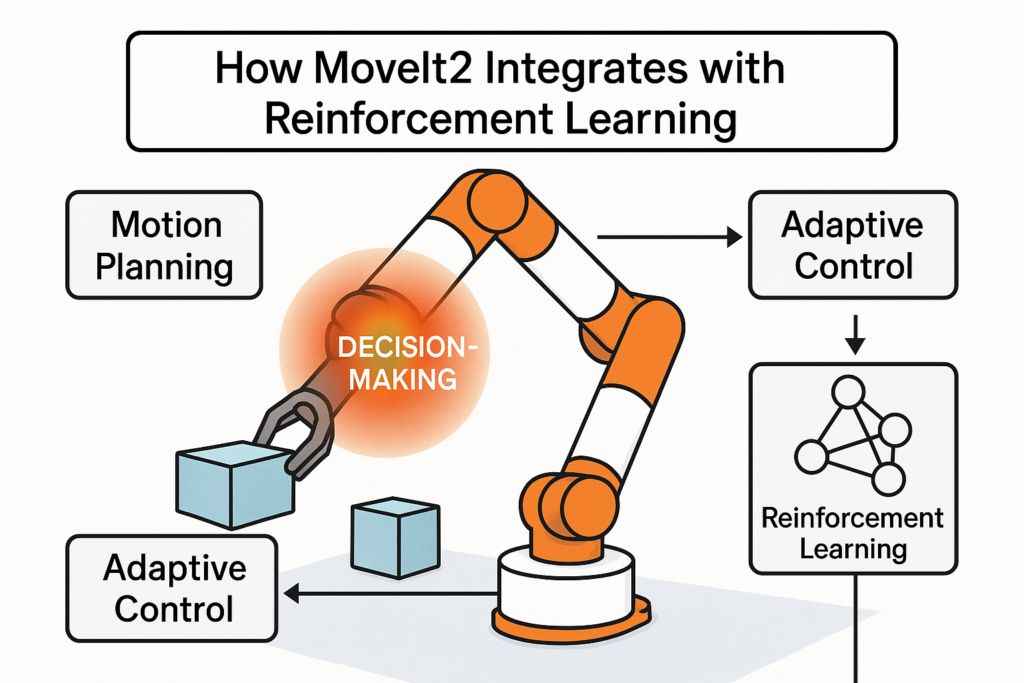MoveIt2, an advanced open-source software for robotic motion planning, builds on the success of its predecessor, MoveIt, within the Robot Operating System (ROS) ecosystem. Its integration with reinforcement learning (RL) marks a significant leap forward in robotic manipulation, enabling robots to learn from interactions and improve their decision-making capabilities over time. This article explores how RL enhances MoveIt2’s functionalities, making robots more adaptive and efficient in complex environments.
Enhancing MoveIt2 with Reinforcement Learning
Adaptive Motion Planning
One of the core strengths of integrating RL with MoveIt2 is the enhancement of motion planning capabilities. Traditional algorithms, while robust, often struggle with unpredictability and dynamic changes in the environment. RL allows robots to learn optimal paths and strategies through trial and error, continuously refining their approach based on feedback from their environment. This adaptive learning is crucial for applications requiring high degrees of flexibility and precision.
Improved Control Strategies
RL algorithms such as Deep Deterministic Policy Gradient (DDPG) or Proximal Policy Optimization (PPO) provide frameworks through which robots can develop sophisticated control strategies. These strategies are learned directly from the system’s performance, adjusting actions in real-time to meet complex objectives. For instance, a robot arm learning to assemble parts might adjust its grip or force applied based on the varying shapes or materials of components, all learned through continuous interaction and adjustment.
Multi-Agent Coordination
MoveIt2, combined with RL, can significantly enhance multi-agent coordination. In environments where multiple robots operate simultaneously, RL can facilitate effective collaboration and task sharing. Techniques like the Actor-Attention-Critic model enable individual agents to consider the actions and states of their peers, promoting harmonious and synchronized actions across the group. This is especially beneficial in settings like automated warehouses or complex manufacturing lines where multiple robots work in concert.
Real-World Applications of RL in MoveIt2
Industrial Automation
In industrial settings, RL-equipped robots can dramatically improve efficiency and adaptability. For example, in manufacturing, robots can learn to optimize assembly lines, adjusting their movements to minimize time and resource usage while maximizing output quality. This adaptability also allows robots to handle unexpected situations, such as equipment malfunctions or irregular input materials, without human intervention.
Precision Tasks
In fields requiring high precision, such as electronics assembly or medical procedures, RL can enable robots to perform with greater accuracy. By continuously refining their techniques based on success rates and error margins, these robots can achieve levels of precision that are challenging for human workers, often in a fraction of the time.
Exploratory Robotics
For exploratory missions, such as space exploration or underwater research, RL allows robots to navigate and manipulate in unstructured and unknown environments. Robots can learn to identify obstacles, map terrains, and interact with objects with little prior knowledge, adapting their strategies based on real-time data.
Challenges and Future Directions
While the integration of RL with MoveIt2 offers numerous benefits, it also presents challenges. The variability in RL outcomes, based on different initial conditions and training environments, can affect consistency. The computational demands of training complex RL models are also significant, requiring substantial resources for data processing and model training.
Future advancements may focus on creating more efficient training algorithms that reduce computational demands and improve learning speed. Additionally, enhancing the safety protocols within these systems to ensure reliable operation in real-world applications will be crucial. Researchers are also exploring ways to improve the interpretability of RL models, making their decisions more transparent and trustworthy.
Conclusion
The integration of reinforcement learning with MoveIt2 opens up a new frontier in robotics, enhancing the capabilities of robots to learn, adapt, and perform complex tasks with unprecedented efficiency and precision. As this technology continues to evolve, it promises to revolutionize industries, from manufacturing to exploration, by enabling more autonomous and intelligent robotic systems. The synergy between MoveIt2 and reinforcement learning not only pushes the boundaries of what robots can achieve but also paves the way for future innovations in robotic applications.
How does reinforcement learning improve MoveIt2?
Reinforcement learning enhances MoveIt2 by enabling robots to learn from their interactions with the environment, improving their motion planning capabilities, control strategies, and adaptability in dynamic settings.
What are the benefits of integrating RL with MoveIt2?
Integrating RL with MoveIt2 allows robots to optimize their actions based on trial and error, enhance precision in tasks, and improve coordination in multi-robot systems. This leads to better performance in complex environments and tasks such as industrial automation and exploratory missions.
Can MoveIt2 and RL be used for multi-agent systems?
Yes, MoveIt2 combined with RL is highly effective for multi-agent systems, where it helps coordinate multiple robots to work in sync, sharing tasks and adapting to each other’s actions dynamically, which is crucial in environments like manufacturing and logistics.
What are the challenges of using RL in MoveIt2?
The main challenges include the variability in learning outcomes, the high computational demands of training RL models, and ensuring the safety and reliability of autonomous robots in real-world applications.


